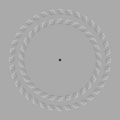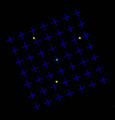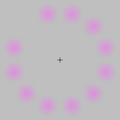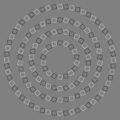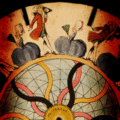Optical illusion facts for kids
An optical illusion (also known as a visual illusion) is when your eyes and brain see something that isn't quite real. It's like a trick played on your vision. What you see doesn't match what is actually there.
Our eyes gather information, and our brain processes it to create a perception of the world. Usually, this works perfectly. But with optical illusions, the brain's interpretation doesn't match the actual object or image.
Contents
What Are Optical Illusions?
Optical illusions happen because of how our brains try to understand what our eyes see. They show us images that look different from reality.
Different Kinds of Illusions
There are three main types of visual illusions:
- Literal optical illusions: These create images that are different from the objects themselves. Think of a picture that looks like one thing, but then you see something else hidden in it.
- Physiological illusions: These happen because of how our eyes and brain react to too much stimulation. This could be from very bright lights, strong colors, or certain patterns. It affects how we see size, position, tilt, or movement.
- Cognitive illusions: These are caused by our brain making quick, unconscious guesses about what we are seeing. Sometimes, these guesses are wrong.
How Our Brains Create Illusions
Many illusions can be explained by how our brain processes information from our senses. It tries to make sense of everything we see. A famous psychologist named Hermann von Helmholtz said that what we perceive is like an "unconscious guess" based on what our senses tell us and what we've learned before.
Another expert, Richard Gregory, explained that our brain makes a "hypothesis" or a best guess about what's out there. Sometimes, this guess isn't quite right, and that's when we see an illusion. His idea is that our perception is a mix of what our eyes see and what we already know or have experienced.
Researcher Mark Changizi thinks optical illusions happen because of a "neural lag." This means there's a tiny delay (about one-tenth of a second) between when light hits your eye and when your brain actually understands what it's seeing.
Changizi believes our visual system has learned to predict the future by a tiny bit. It tries to show us what will happen one-tenth of a second from now. This helps us do things like catch a ball or walk through a crowd without bumping into people. Illusions happen when our brain's prediction of the future doesn't match what's really there.
In simple terms, these ideas are similar. We don't just see things exactly as they are. Instead, our brains work quickly to figure out what we're looking at. This involves using our memory and logic. This process is usually very good, but it's not perfect. When it makes a mistake, we experience an optical illusion.
Images for kids
-
Floor tiles at the Basilica of St. John Lateran in Rome. The pattern makes it look like there are three-dimensional boxes.
-
"The Organ Player" – Pareidolia phenomenon in Neptune's Grotto stalactite cave (Alghero, Sardinia)
-
Ambigram tessellation "Escher" using negative space to reveal letters upside down.
-
Forced perspective: the man is made to appear to be supporting the Leaning Tower of Pisa in the background.
See also
 In Spanish: Ilusión óptica para niños
In Spanish: Ilusión óptica para niños





